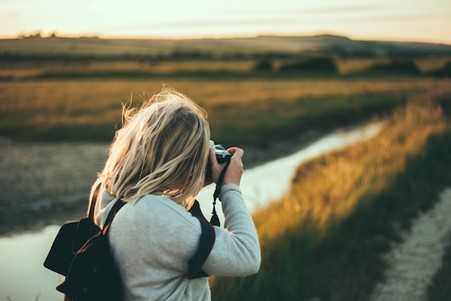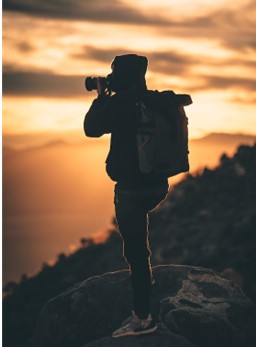Stephanie Marie Sickels is an amateur photographer who enjoys capturing nature’s beauty in her photos – from the garden, to wildlife, to the setting sky. In the following article, Stephanie Sickels explains a few of the best techniques for capturing the best scenery.
Photography saved Yosemite.
Nearly 50 years before the godfather of landscape photography Ansel Adams was even born, it was Carleton Watkins who created images of Yosemite that that directly led to it becoming one the country’s most breathtaking national parks.
Making use of high vantage spots and tons of camera equipment hauled by mules, Watkins expertly crafted images of atmospheric beauty, and his groundbreaking techniques are still used by landscape photographers today.
Stephanie Marie Sickels explains that there are many reasons why landscape photography has never gone out of style, even though it can be a challenging medium to master. The bottom line: It’s still one of the most rewarding photography fields to explore.
Stephanie Sickels on Choosing the Right Camera
Capturing outdoor scenes is a fine art, so a good camera is an essential tool.
Many experts recommend mirrorless and DSLR cameras as the ideal types to shoot stunning landscapes, because of their numerous settings for exposure customization and larger sensors that can produce extremely high-quality photos.
Stephanie Sickels says that even relatively affordable cameras such as one that is full-frame with a 35-millimeter sensor can yield wide views. Just remember to clean the lens regularly to protect its coating.
Then Learning the Camera’s Functions
It’s not enough to just buy a camera because it’s considered landscape photography-friendly — a photographer should learn how to use it inside and out.
Stephanie Marie Sickels says that’s because there are tools to take advantage of for landscape shots. For example, picking the right aperture can make a big difference, with high apertures needed to capture a high depth of field with wide focus. Setting apertures low can blur foreground subjects if a shallower field depth is desired.
Stephanie Sickels explains that a camera’s ISO setting, which lights or darkens images, is also important, since a low ISO setting often ensures the best quality, keeping an image from looking grainy. The ISO setting is also used in tandem with the right exposure and shutter speed, how slow or fast the shutter closes when completing a shot.
Location Research
Landscape photography is a global pursuit for amateurs and professionals alike, and it’s important to take some time to research locations to photograph.
Even if it’s a place the photographer has been to numerous times, it’s beyond helpful to map different routes or mark viewpoints ahead of time — as well as avoid potentially large crowds by picking tucked-away areas.
Stephanie Sickels says that next is planning when to go to take advantage of desired seasonal vantage points. It is also a way to mark locations that may be best at certain times of day, such as sunrise or sunset.
 Consider the Right Light
Consider the Right Light
The amount of light has a strong influence on the evocative nature of landscape photography. The right light varies depending on factors such as weather and photo goals, but early morning and late afternoon light are often considered the best for landscape images. Another option is just after sunset or right before sunrise.
Stephanie Marie Sickels reports that some of the best landscape photography captures cloudy and stormy days so close-to-technically-perfect light isn’t always required.
Try Different Composition Approaches
Practice makes perfect in photography, and it may take a while to develop an eye for how to best arrange different image elements. However, there are different composition techniques to integrate, such as leading lines, rule of thirds, and symmetry.
Filter Selection
Stephanie Sickels explains that landscape photography can be elevated through the use of two types of lens filters. The polarizing filter helps make elements pop in photography since it tempers glare and takes care of light reflections. Polarizing filters can improve colors immediately as well as the photo’s general appearance.
With a neutral density filter, a photographer can filter out different light amounts in order to use high ISO levels, slow shutter speeds, and wide apertures in a way that doesn’t risk image overexposure.
Look Up
Landscape images require looking at the big picture of a scene, and that means considering how the sky balances with the land in the image. The sky can be its own character, whether it contains the dark clouds of an impending storm or the stark white clouds of a gorgeous blue-sky day.
Stephanie Sickels explains that sometimes the sky doesn’t want to cooperate, and that’s OK. A dull, unremarkable, or partly sunny sky means taking the focus elsewhere or integrating more land.
Final Thoughts
Remember that mastery in photography is an ever-evolving journey. The world is a canvas, and with the right techniques, anyone can hold the power to immortalize its beauty in a single frame. Embrace the interplay of light, composition, and patience. Seek out unique perspectives and let creativity flow. And always remember, the most stunning landscapes often require dedication and a discerning eye. So, venture forth with a camera in hand, and let the world witness your extraordinary vision through the lens. With these techniques at your disposal, your landscape photography will not only capture scenes, but evoke emotions, leaving viewers spellbound and inspired by the wonders of our natural world.



 Consider the Right Light
Consider the Right Light


